
Imagine a society that spends more money on keeping its prison system alive rather than educating their citizens. Imagine a society where you soon might have more youth spending time behind bars than behind the desk.
There is no need to imagine this kind of society; this is our reality.
The United States – especially California, which has one of the highest incarceration rates in the country – needs to reconsider its priorities when it comes to funding public education versus prisons. Gov. Jerry Brown’s 2012-13 budget allocated nearly $1 billion more to prison spending than to higher education.
The solution to our economic problems should not be weighted on the backs of students, and universities should not have to compete with prisons for state funding. We need to prioritize public education as an inalienable right and transition towards making the institution very affordable, if not cost-free to students.
According to the National Center for Education Statistics, a record 19.7 million students were expected to attend American colleges and universities in Fall 2011 – an increase of about 4.4 million since 2000.
Some have argued that through charging students more for their studies, the government will gain more money and use it to supplement lacking tax revenue. From the perspective of public school officials like the CSU board of trustees, an increase in tuition fees seems like the only solution to a shrinking educational budget during one of the worst recessions in history.
The problem lies in allocation. Because funding for both institutions come from the same California General Fund, prisons and universities are actually in competition with each other. According to research by California Common Sense, California’s higher education received 13 percent less state funding in 2011 than it did in 1980, while funding for prisons expanded 436 percent during the same period.
Dr. Tracy Lachica Buenavista, who teaches research methods in the department of Asian American studies, stated that though the relationship between education funding and the “prison industrial complex” is complicated, there is an identifiable correlation between the two.
“Research that has found that access to education is a deterrent to incarceration,” said Buenavista. “If they have an access to education, they are less likely to be incarcerated.”
Our budget priorities also impact the number of participants each institution can serve and maintain. According to the California Department of Corrections and Rehabilitation, the total prison population in California was 124,00 in June – 155 percent above “design capacity.” The age group that spends most time behind bars are those between 20-24 year old – a common age for college students.
By divesting from education, we are possibly increasing the population most prone to getting caught up in the prison system – the socio-economically disadvantaged.
“There is a larger police presence in areas that are more economically disenfranchised,” said Buenavista. “The likelihood that low-income and poor people will be policed or incarcerated is greater.”
Not only does higher education deter young people from prisons, education can sometimes be the only opportunity for low-income people to lift themselves out of poverty or low social status.
“Without viable access to higher education, people who are economically disenfranchised are more likely to have just three options for life opportunities: low paying jobs, the military, and incarceration,” said Buenavista. “Without higher education, those who find themselves in poverty don’t have much opportunity for socio-economic mobility.”
Divesting from education impacts existing students. It is likely that the number one reason why students drop out of higher education is that they can no longer afford the high cost of tuition. A 2011 survey titled “Trends in College Pricing,” conducted by the College Board shows that the average cost for tuition and fees at four-year public institutions has increased nearly 51 percent over the last 10 years.
“Today, more so than any other time in California’s history, the government is giving the least amount in funding to higher education than it has ever given,” said Buenavista. “The students have to fund their higher education, rather than it being subsidized by the government.”
By contrast, college education is free and funded by the government in many other industrialized, first-world countries, such as Sweden. Many critics point out that the taxes in Sweden are relatively higher because they fund social services such as education and health care. But when education is treated as a societal benefit rather than a private good, it will not only benefit students, but likely decrease the prison population.
According to a 2010 report by The International Center for Prison Studies, the US has both the largest incarcerated population and the highest per-capita incarceration rate in the world, with 748 inmates per 100,000 residents. Meanwhile, Sweden imprisons about 80 people per 100,000 of population.
Having a degree typically results in gaining higher levels of employment and earnings. With a free and fair education system, the likelihood of people relying on public money for welfare is decreased. When the responsibility to fund the education system is taken seriously by governments, we will be on track to ending systemic inequality and help all our people to succeed, regardless of individual circumstance.
— Muna Adem is a Communications and Journalism double major and international student from Sweden.





